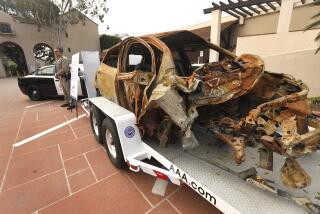Invulnerable Drunk Driver Called a Myth
- Share via
It is a news story that appears with horrifying regularity: A drunk driver crashes into a sober one, and the sober person dies while the drunk suffers only minor injuries.
So often have such anecdotes been told in newspapers and on television that many people believe being intoxicated actually helps prevent injuries in highway collisions. But like much conventional wisdom, the image of the invulnerable drunk driver is mere myth, experts say.
In fact, they say, research shows the opposite: Drunk drivers are more likely to be killed or injured in crashes than those who are not intoxicated.
“All the studies show no value to being drunk,” said Dr. Ricardo Martinez, head of the National Highway Traffic Safety Administration. “That’s a myth that won’t go away.”
Of the 13,094 crash fatalities last year involving at least one person who was legally intoxicated, 7,281 of those killed were intoxicated drivers and only 865 were sober drivers, according to the NHTSA.
Many crashes in which the driver is intoxicated involve only a single vehicle that runs off a road or hits a tree, experts said.
“Drunks kill themselves more than they kill anyone else,” said Terry Schiavone, president of the National Commission Against Drunk Driving, a nonprofit group in Washington.
A 1986 study by University of North Carolina researchers of more than 1 million drivers involved in crashes concluded that drunk drivers die or suffer serious injury more often than sober ones in comparable crashes.
“These findings do not support the widespread belief that alcohol is protective against injury, but rather indicate that alcohol increases vulnerability to injury in any given crash,” said the study, which took into account such factors as seat belt use, speed, vehicle condition and driver age.
But because media often publicize crashes where drunk drivers kill innocent family members while rarely covering single-vehicle crashes, experts say, the public has come to believe the old proverb that “God protects small children and drunks.”
Dr. Donald Reinfurt, deputy director of the University of North Carolina’s Highway Safety Research Center, said he was unaware of any research on who is more likely to survive when a drunk runs into an unintoxicated person.
But Tim Hurd, a spokesman for the federal traffic safety agency, said factors such as crash speed, vehicle weight and what part of the vehicle was struck determine which driver survives--not which one was under the influence.
Reinfurt said many people believe that “loosey and goosey” drunk drivers survive crashes better because they are more relaxed and “roll around inside the car and that protects them.”
But, he said, “I’m convinced that is not correct. [A drunk driver] is more likely to be seriously injured or killed.”
Experts said alcohol increases the likelihood of death or serious injury because its erodes the body’s ability to survive trauma.
Martinez said alcohol slows cardiac and central nervous function by disrupting electrical activity in the heart and brain. It also suppresses the immune system, making drunks who are hurt more susceptible to later infection, he said.
Moreover, Reinfurt said, drunk drivers are less likely to be wearing seat belts, which double one’s chances of surviving a highway crash.
Also, he said, drunk drivers often run into the rear of other cars, which absorb much of the impact for a sober driver while hurling a drunk driver into a steering column or windshield.
More to Read
Sign up for Essential California
The most important California stories and recommendations in your inbox every morning.
You may occasionally receive promotional content from the Los Angeles Times.













